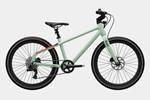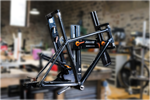Lehvoss provides evidence of extreme resilience of composites through e-bike expedition
Lehvoss’ carbon fiber-reinforced thermoplastic composite materials are being used in the production of an e-bike set that will taken an expedition across North Africa.

Photo Credit: Lehvoss
At the beginning of 2024, three riders, Mike Fuchs, Oliver Gehrking and David Arlandis, will set off on a sustained journey. The riders will travel from Germany to North Africa where they will bike approximately 1,300 kilometers through mountains, snowfields and the hot desert, showcasing that bicycle frames and components made of thermoplastic composites can withstand even the toughest demands.
The bicycle that will carry the bikers throughout this journey is the Buddy X1 e-bike from Buddy Bike and (Saalfeld, Germany)/ (Schmiedefeld, Germany). Together, the partners develop high-quality composite e-bikes that stand out for design, quality, durability and environmental friendliness (read “Isoco, V Frames, Lehvoss introduce recycled, biopolymer composites to bike frames”). In central Europe, the bikes are available and for sale under the name Isoco X1.
Buddy’s frame itself is manufactured in Germany by Isoco/V Frames. Thermoplastic carbon fiber plastics from (Hamburg, Germany) are used for the production. The V Frames bicycle frames have a 68% lower carbon footprint than traditional aluminum. Additionally, the V Frames bicycle frames are lighter than aluminum frames and are 100% recyclable at the end of their service life. The Buddy X1 frame has passed all tests relevant to its class as the first tool-drop, injection-molded frame.
The thermoplastic bicycle frames were compared with welded aluminum frames. Aluminum, like the Lehvoss material used here, is recyclable. Composite frames are based on a mixture of thermoset resin and carbon fibers and cannot be recycled in a technically or ecologically sensible manner.
Fuchs, Gehrking and Arlandis will be on the road in a very sensitive and challenging ecosystem. On e-bikes, and with components that are all heavy-duty, they aim to prove that such a demanding expedition is also possible while consistently implementing the idea of sustainability.
Related Content
-
Otto Aviation launches Phantom 3500 business jet with all-composite airframe from Leonardo
Promising 60% less fuel burn and 90% less emissions using SAF, the super-laminar flow design with windowless fuselage will be built using RTM in Florida facility with certification slated for 2030.
-
Carbon fiber, bionic design achieve peak performance in race-ready production vehicle
Porsche worked with Action Composites to design and manufacture an innovative carbon fiber safety cage option to lightweight one of its series race vehicles, built in a one-shot compression molding process.
-
Sulapac introduces Sulapac Flow 1.7 to replace PLA, ABS and PP in FDM, FGF
Available as filament and granules for extrusion, new wood composite matches properties yet is compostable, eliminates microplastics and reduces carbon footprint.





